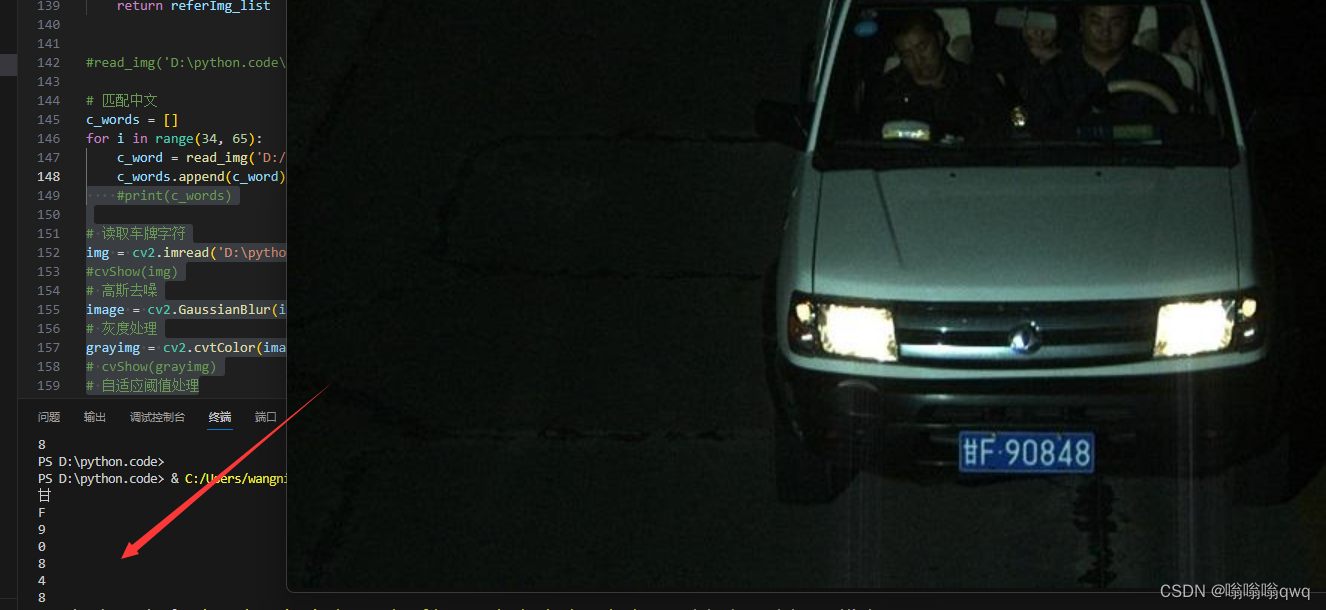车牌识别python
发布时间:2024年01月04日
直接上代码:
import os
import cv2
import numpy as np
# 显示图片
def cvShow(img):
cv2.imshow('0', img)
cv2.waitKey()
Img = cv2.imread("D:\python.code\carRead\car/img.png")#D:\python.code\carRead\car\img3.png
cvShow(Img)
# 高斯去燥
Img1 = cv2.GaussianBlur(Img, (3, 3), 0)
# cvShow(Img1)
# 灰度处理
grayImg = cv2.cvtColor(Img1, cv2.COLOR_BGR2GRAY)
# cvShow(grayImg)
# 边缘检测
# Soble算子边缘检测
Sobel_x = cv2.Sobel(grayImg, cv2.CV_16S, 1, 0)
sImg = cv2.convertScaleAbs(Sobel_x)
# cvShow(sImg)
# 自适应阈值处理
ret, img = cv2.threshold(sImg, 0, 255, cv2.THRESH_OTSU)
# cvShow(img)
# 闭运算
# 先膨胀在腐蚀
kernelX = cv2.getStructuringElement(cv2.MORPH_RECT, (14, 3))
# print(kernelX)
image = cv2.morphologyEx(img, cv2.MORPH_CLOSE, kernelX, iterations=2)
# cvShow(image)
# 去除小白点
kernelX = cv2.getStructuringElement(cv2.MORPH_RECT, (20, 1))
kernelY = cv2.getStructuringElement(cv2.MORPH_RECT, (1, 19))
# 膨胀,腐蚀
image = cv2.dilate(image, kernelX)
image = cv2.erode(image, kernelX)
# 腐蚀,膨胀
image = cv2.erode(image, kernelY)
image = cv2.dilate(image, kernelY)
# cvShow(image)
# 中值滤波去除噪点
image = cv2.medianBlur(image, 15)
# cvShow(image)
# 轮廓检测
# cv2 RETR_EXTERNAL 表示只检测外轮廓
# cv2.CHAIN_APPROX_SIMPLE压水平方向,垂直方向,对角线方向的元素,只保留该方向的终点坐标,例如一个矩形轮只需4个点来保存轮席信息
contours, hierarchy = cv2.findContours(image, cv2.RETR_EXTERNAL, cv2.CHAIN_APPROX_SIMPLE)
# 绘制轮廓
Img2 = Img.copy()
cv2.drawContours(Img2, contours, -1, (0, 0, 255), 1)
# cvShow(Img2)
# 筛选车牌位置的轮廓
# 车牌长宽比在3:1到4:1之间
for item in contours:
# cv2.boundingRect用一个最小的巨型,把形状包起来
rect = cv2.boundingRect(item)
x = rect[0]
y = rect[1]
weight = rect[2]
height = rect[3]
if (weight > (height * 3)) and (weight < (height * 4.5)):
rectImg = Img[y:y + height, x:x + weight]
cv2.imwrite('D:\python.code\carRead\license/license_plate.png', rectImg)#\是路径,/是文件名
# cvShow(rectImg)
# 高斯去噪
carImg = cv2.GaussianBlur(rectImg, (3, 3), 0)
# cvShow(carImg)
# 灰度化
grayCarImg = cv2.cvtColor(carImg, cv2.COLOR_BGR2GRAY)
# cvShow(grayCarImg)
# 自适应阈值处理
ret, image = cv2.threshold(grayCarImg, 0, 255, cv2.THRESH_OTSU)
# cvShow(image)
# 膨胀
kernel = cv2.getStructuringElement(cv2.MORPH_RECT, (2, 2))
img = cv2.dilate(image, kernel)
# cvShow(img)
# 轮廓检测
contours1, hierarchy1 = cv2.findContours(img, cv2.RETR_EXTERNAL, cv2.CHAIN_APPROX_SIMPLE)
img1 = rectImg.copy()
cv2.drawContours(img1, contours1, -1, (0, 0, 255), 1)
# cvShow(img1)
# 筛选出各个字符的位置轮廓
words = []
for item in contours1:
word = []
rect = cv2.boundingRect(item)
x = rect[0]
y = rect[1]
weight = rect[2]
height = rect[3]
word.append(x)
word.append(y)
word.append(weight)
word.append(height)
words.append(word)
words = sorted(words, key=lambda s: s[0], reverse=False)
# print(words)
i = 0
for word in words:
# 根据每个字符的高度进行筛选
# if (word[3] > (word[2] * 1.5)) and (word[3] < (word[2] * 4.0)):
if (word[3] > 20) and (word[3] < 50) and (word[2] > 3) and (word[2] < 25):
i = i + 1
if i == 8:
break
else:
image = rectImg[word[1]:word[1] + word[3], word[0]:word[0] + word[2]]
# cvShow(image)
# print(word)
cv2.imwrite('D:\python.code\carRead\words/' + str(i) + '.png', image)
templates = ['0', '1', '2', '3', '4', '5', '6', '7', '8', '9',
'A', 'B', 'C', 'D', 'E', 'F', 'G', 'H', 'J', 'K', 'L', 'M', 'N', 'P', 'Q', 'R', 'S', 'T', 'U', 'V',
'W', 'X', 'Y', 'Z',
'藏', '川', '鄂', '甘', '赣', '贵', '桂', '黑', '沪', '吉', '冀', '津', '晋', '京', '辽', '鲁', '蒙', '闽',
'宁', '青', '琼', '陕', '苏', '皖', '湘', '新', '渝', '豫', '粤', '云', '浙']
# 读取图片 输入参数是目录名
def read_img(road):
referImg_list = []
for filename in os.listdir(road):
#print(filename)
referImg_list.append(road + '/' + filename)
# print(referImg_list)
return referImg_list
#read_img('D:\python.code\carRead\model')
# 匹配中文
c_words = []
for i in range(34, 65):
c_word = read_img('D:/python.code/carRead/model/' + templates[i])
c_words.append(c_word)
#print(c_words)
# 读取车牌字符
img = cv2.imread('D:\python.code\carRead\words/1.png')
#cvShow(img)
# 高斯去噪
image = cv2.GaussianBlur(img, (3, 3), 0)
# 灰度处理
grayimg = cv2.cvtColor(image, cv2.COLOR_RGB2GRAY)
# cvShow(grayimg)
# 自适应阈值处理
ret, image1 = cv2.threshold(grayimg, 0, 255, cv2.THRESH_OTSU)
# cvShow(image)
best_score = [] # 存取每个省市最高的得分
for c_word in c_words:
score = [] # 存取的时每个省市的得分
for word in c_word:
# 读取模板中的照片
# formfile()函数读回数据时需要用户指定元素类型,并对数组形状进行适当的修改
template_img = cv2.imdecode(np.fromfile(word, dtype=np.uint8), 1)
# 灰度处理
template_img = cv2.cvtColor(template_img, cv2.COLOR_RGB2GRAY)
# 自适应阈值处理
ret, template_img = cv2.threshold(template_img, 0, 255, cv2.THRESH_OTSU)
# 获取模板的长宽
height, width = template_img.shape
# 复制车牌字符图片
image = image1.copy()
# 让两者具有相同的长宽
image = cv2.resize(image, (width, height))
# 两者进行匹配 TM_CCOEFFF 匹配程度越高,计算出来的值越大
result = cv2.matchTemplate(image, template_img, cv2.TM_CCOEFF)
score.append(result[0][0])
best_score.append(max(score))
# 获取最高得分元素的下标
num = best_score.index(max(best_score))
print(templates[num + 34],end='')
# 识别车牌第二个字母
# 读取图片
img = cv2.imread('D:\python.code\carRead\words/2.png')
# cvShow(img01)
# 高斯去噪
img = cv2.GaussianBlur(img, (3, 3), 0)
# 灰度处理
img = cv2.cvtColor(img, cv2.COLOR_RGB2GRAY)
# cvShow(img)
# 自适应阈值处理
ret, image2 = cv2.threshold(img, 0, 255, cv2.THRESH_OTSU)
# cvShow(image2)
# 字母模板匹配
c_words = []
for i in range(10, 34):
# print(templates[i])
c_word = read_img('D:/python.code/carRead/model/' + templates[i])
c_words.append(c_word)
# print(c_words)
best_score = [] # 存取每个省市最高的得分
for c_word in c_words:
score = [] # 存取的时每个省市的得分
for word in c_word:
# 读取模板中的照片
# formfile()函数读回数据时需要用户指定元素类型,并对数组形状进行适当的修改
template_img = cv2.imdecode(np.fromfile(word, dtype=np.uint8), 1)
# 灰度处理
template_img = cv2.cvtColor(template_img, cv2.COLOR_RGB2GRAY)
# 自适应阈值处理
ret, template_img = cv2.threshold(template_img, 0, 255, cv2.THRESH_OTSU)
# 获取模板的长宽
height, width = template_img.shape
# 复制车牌字符图片
image = image2.copy()
# 让两者具有相同的长宽
image = cv2.resize(image, (width, height))
# 两者进行匹配 TM_CCOEFFF 匹配程度越高,计算出来的值越大
result = cv2.matchTemplate(image, template_img, cv2.TM_CCOEFF)
score.append(result[0][0])
# print(word)
# print(score)
best_score.append(max(score))
# print(best_score)
# 获取最高得分元素的下标
num = best_score.index(max(best_score))
print(templates[10 + num],end='')
def strOrnum(path):
# 读取图片
img = cv2.imread(path)
# cvShow(img01)
# 高斯去噪
img = cv2.GaussianBlur(img, (3, 3), 0)
# 灰度处理
img = cv2.cvtColor(img, cv2.COLOR_RGB2GRAY)
# cvShow(img)
# 自适应阈值处理
ret, image2 = cv2.threshold(img, 0, 255, cv2.THRESH_OTSU)
# cvShow(image2)
# 字母模板匹配
c_words = []
for i in range(0, 34):
# print(templates[i])
c_word = read_img('D:/python.code/carRead/model/' + templates[i])
c_words.append(c_word)
# print(c_words)
best_score = [] # 存取每个省市最高的得分
for c_word in c_words:
score = [] # 存取的时每个省市的得分
for word in c_word:
# 读取模板中的照片
# formfile()函数读回数据时需要用户指定元素类型,并对数组形状进行适当的修改
template_img = cv2.imdecode(np.fromfile(word, dtype=np.uint8), 1)
# 灰度处理
template_img = cv2.cvtColor(template_img, cv2.COLOR_RGB2GRAY)
# 自适应阈值处理
ret, template_img = cv2.threshold(template_img, 0, 255, cv2.THRESH_OTSU)
# 获取模板的长宽
height, width = template_img.shape
# 复制车牌字符图片
image = image2.copy()
# 让两者具有相同的长宽
image = cv2.resize(image, (width, height))
# 两者进行匹配 TM_CCOEFFF 匹配程度越高,计算出来的值越大
result = cv2.matchTemplate(image, template_img, cv2.TM_CCOEFF)
score.append(result[0][0])
best_score.append(max(score))
# 获取最高得分元素的下标
num = best_score.index(max(best_score))
print(templates[num],end='')
strOrnum('D:\python.code\carRead\words/3.png')
strOrnum('D:\python.code\carRead\words/4.png')
strOrnum('D:\python.code\carRead\words/5.png')
strOrnum('D:\python.code\carRead\words/6.png')
strOrnum('D:\python.code\carRead\words/7.png')

可以用作学习参考
文章来源:https://blog.csdn.net/qq_54122113/article/details/135365526
本文来自互联网用户投稿,该文观点仅代表作者本人,不代表本站立场。本站仅提供信息存储空间服务,不拥有所有权,不承担相关法律责任。 如若内容造成侵权/违法违规/事实不符,请联系我的编程经验分享网邮箱:chenni525@qq.com进行投诉反馈,一经查实,立即删除!
本文来自互联网用户投稿,该文观点仅代表作者本人,不代表本站立场。本站仅提供信息存储空间服务,不拥有所有权,不承担相关法律责任。 如若内容造成侵权/违法违规/事实不符,请联系我的编程经验分享网邮箱:chenni525@qq.com进行投诉反馈,一经查实,立即删除!
最新文章
- Python教程
- 深入理解 MySQL 中的 HAVING 关键字和聚合函数
- Qt之QChar编码(1)
- MyBatis入门基础篇
- 用Python脚本实现FFmpeg批量转换
- 浏览器 标签栏 代码 - 删除
- 【Linux】修复 Linux 错误 - 磁盘配额超限
- CVE-2022-22978 Spring Security越权访问漏洞
- 激活/注册navicat15
- 点赋网络科技,探索时光里的咖啡记忆
- 使用qtcreator创建qml项目(图解)
- 软件性能测试如何分类?广东省CMA、CNAS软件检测机构有哪些?
- 用Axure RP 9 制作联动
- 图片怎么提取文字?教你3个提取方法
- 组件v-model(.sync)记录使用(vue3)